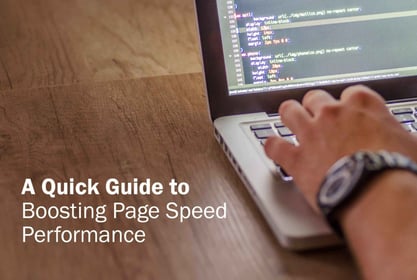
Page speed is still a hot topic! As Google’s mobile-first indexing continues to roll-out, the role of website page speed – specifically mobile page load times – as a search engine ranking factor is getting a lot of attention. Ranking is only one relatively small aspect of page speed’s importance for your website performance.
Why is Page Speed Important?
Page speed, especially mobile page speed, affects web page performance and how well your page will rank on a search engine results page (SERP). Google, Amazon, and others have discovered that the effect of page speed on user experience is even more dramatic.
For example:
- In 2009, Google ran experiments to measure the impact of page speed on the user search experience. Google discovered that slowing down page load times from 100 – 400 milliseconds produced a measurable decrease in user search and user satisfaction.
- In 2012, Amazon determined slowing a page load by even one second could cost the company $1.6 billion in sales every year.
- In 2014, Walmart discovered that reducing page load time by one second increased traffic by 2%.
- Google reported in 2018 that 53% of mobile users leave a page that takes more than 3 seconds to load.
For mobile page speed load times, Google noted in the 2018 report that “it took more than seven seconds to fully load all visual content above and below the fold.” The report also noted:
“Our data shows that while more than half of overall web traffic comes from mobile, mobile conversion rates are lower than desktop. In short, speed equals revenue.”
How Will Page Speed Affect Your Website Performance in 2018 and Beyond?
Page speed will be one of the biggest technical SEO and user experience factors in SERP ranking moving forward. How fast a page loads will be measured by the search engines. In terms of user experience, you can expect your target audience to have high expectations. To stay relevant, you’ll need to be at least as good as your competition.
What Causes a Web Page to Load Slowly?
Many technical elements can contribute to slow page load times, but the most common ones are:
- Images. Large image file sizes are always a problem.
- Plug-ins or any third-party element.
- Complex themes or large files on a page.
- Redirects.
Fortunately, there are plenty of tools you can use for measuring and monitoring page speed that can identify the problem(s) on any given page.
Tools for Site Speed Monitoring
Here are several great (and free!) tools to test your site speed:
- Google’s PageSpeed Insights. This free tool tells you how your page loads on both desktop and mobile. It also offers instructions on what steps to take to improve it, prioritizing the elements that will have the greatest impact. Plus, it’s a Google tool, which means it probably “knows” what the search engine is looking for.
- Pingdom. This is another free website speed tool that offers guidance on how to correct any factors slowing down your site.
- WebPageTest. With this free page speed tool, you can run basic tests or choose advanced settings. You’ll get detailed reporting and recommendations on how to improve the page.
- GTmetrix. Page load details, page speed and advanced analysis options with reporting that includes waterfall charts and more make this another great tool for page speed optimization.
The only drawback to these tools is that you need to test each web page individually. For an enterprise site, this can quickly become a laborious task. Enterprise SEO platforms, or the agencies that run them, can help address this challenge.
Tips to Improve Your Page Speed Performance
Once you’ve run a test, you’ll get a lot of feedback about your page. You’ll be able to address most of these issues by doing the following:
- Create smaller image file sizes. If you have large images, compressing them will have a big impact on your page load speed. Convert .png to compressed .jpgs is one way to do it. You can also keep it simple with free tools like Optimizilla and ResizeImage.net.
- Enable browser caching. Using a tool that serves a cached version of the page prevents the page from being dynamically loaded with every request.
- Address redirects. If you’ve got a lot of permanent (301) or temporary (307) redirects, these can drag on your load times. Determine if you need them and eliminate or optimize them as appropriate.
- Clean-up Javascript and CSS resource requests. Also called “minifying,” this involves compressing code to reduce the number of client-server requests made.
- Fragment Caching. Reducing the amount of code on each page by storing repetitive data in an external file makes loading a page much simpler.
- Leverage a Content Delivery System (CDN). Large sites that serve a lot of content to users around the world can benefit by a CDN that lets the closest server supply the data to local users. Being geographically close might not seem like it should matter, but it does.
Make Page Speed Optimization a Technical SEO Priority
For all the conversation about the importance of page speed on ranking, it’s impact on engagement, conversion and ultimately revenue – aka user experience! – makes it a priority for every brand in a mobile-first indexing world.
Questions about how best to optimize your page speed? Let’s connect and see what makes sense for you.

The BFO Team
Here at BFO, we're always striving to bring you the latest and greatest in digital marketing insights and education. We're not ones to brag, but we've been lucky enough to be featured in all sorts of fancy publications and media outlets, strutting our stuff and showing off our industry expertise.
CATEGORIES
SUBSCRIBE TO OUR BLOG
Stay up to date with the latest industry best practices in digital marketing!























.png?width=339&height=179&name=Webinar%20Banner%20(1).png)



.png?width=339&height=179&name=July%20Webinar%20(Newsletter).png)

.png?width=339&height=179&name=Webinar%20Banner-April-02%20(1).png)
%20(4).png?width=339&height=179&name=Webinar%20Banner-May-02%20(1)%20(4).png)




.png?width=339&height=179&name=March%202023%20Webinar%20Ad%20(autoresponder).png)

















































